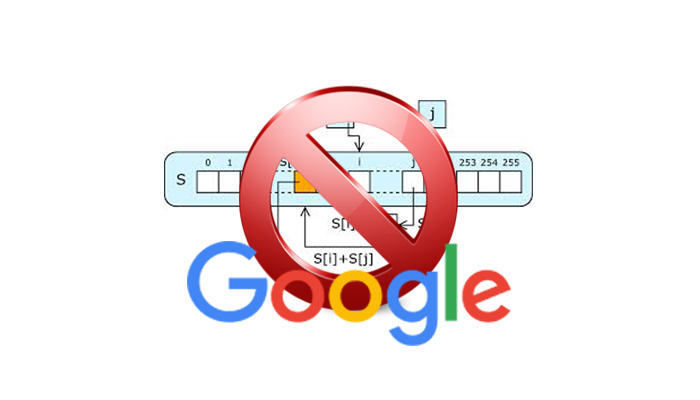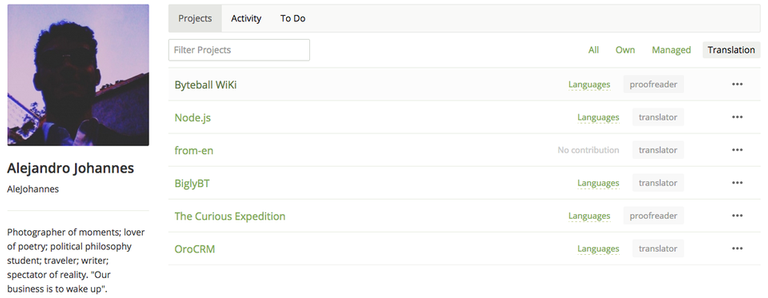Github Repository
https://github.com/nodejs/i18n
Project Details
By definition, Node.js is a Java Runtime Environment (JRE). But it is more than just that. While common JREs function as machine backups that allow users to smoothly run JavaScript on their browsers and applications, this open-source project functions as an app that manages Java code by itself. It's practical uses for developers are endless. It grants an extraordinarily versatile platform for designing code, programs, websites and other applications. And that isn't all: Node provides a virtual facility for testing the proper work of Java-driven programs and devices –and their planned updates–, helping to find bugs, solve errors, fix code and vastly improving their performance.
I believe all the amazing uses of Node are to be considered by themselves and I declare myself a fan of the project. But, besides, I support it for its functionality as a medium for bringing to reality countless creations that can be as good as Node itself. If you can dream it –and code it in JavaScript–, then your imagination is the only limit!The open translation of Node to thirty-three (33) languages proves the advantages of open-source projects when it comes to diversification of knowledge and worldwide spreading of useful tools.
Ahead, there is the link of the program's webpage:
Contribution Specifications
Translation Overview
This is my 31st contribution to Node.js as a translator. For this collaboration, I continued my previous work on the CHANGELOG_IOJS.md file, which –as its name indicates– contains the changelog of the io.js’ version of Node.
As I explained in my past translation reports, a changelog is a registry of all the changes made on determined project for each one of its versions. The files created for such purpose list modifications on internal components, substitutions of protocols, updates, deprecations, addition of supported tools, new functions, corrected errors and fixed bugs. In summary: every feature that first appeared or was removed in the program version being addressed must be specified and described in this registry. This is made with the purpose of providing a timeline of the development of the project and, by doing so, helping programmers to check any details they need to understand the way it came to be what it is and improve it in the future.
I'll refer two of the logs I translated to illustrate the dynamics of the changelog. Both of them are included in the "Commits" section of the addressed file's stable version 1.3.0. The first one goes:
There are two important concepts involved in this log and, before we can understand it, we need to address them individually.
The first one is "Perfect Forward Secrecy (PFS)". Also known as just Forward Secrecy (FS), it is a security feature shared by specific key agreement protocols. It provides the assurance that no matter the future conditions of the server where a session is being held, the specific keys of such session will not be compromised. This provides further guarantee of the protection of your data as an user than just relying on TLS, SSL, HTTP and HTTPS.
Say that, during your session, I manage to hack the system and obtain the private key and the server key and want to get to your data... Since it doesn't allow me to get the key of said session, this is what the PFS would say:
The second one is "RC4". Standing for Rivest Cipher 4, RC4 is a stream cipher known for its simplicity and high speed connection capability, but also for its security vulnerabilities. It was firstly developed in 1987, but became heavily widespread during the late 90's and early 2000's. While being commonly used in TLS protocol, its lacking of security guarantees came obvious, getting it prohibited from it and unrecommended by most digital security providers in 2015. Many enterprises, concerned, echoed this call, removing it from their services... Google was one of those!
Knowing all this, we understand that the referred commit seeks to increase the security of data when using the TLS and HTTPS protocols. This requires that the ciphers used by Node.js assure the achievement of PFS... And RC4 ciphers must be excluded from that set and just accepted, exceptionally, at the own risk of users.
The second log I'll refer is this one:
We could perfectly understand this log... "Add some benchmarks for..." If it wasn't because of the term "querystring". And what is it? Well, just what is sounds like: a string for querying for data. Querystrings are used to request specific information from databases that can be accessed from the program in execution and might be used in its processes.
You can check some references here for more information about the previously addressed concepts:
- https://www.techopedia.com/definition/1782/perfect-forward-secrecy-pfs
- https://whatis.techtarget.com/definition/perfect-forward-secrecy
- https://en.wikipedia.org/wiki/Forward_secrecy
- http://www.crypto-it.net/eng/symmetric/rc4.html
- https://www.techopedia.com/definition/1786/rc4
- https://en.wikipedia.org/wiki/RC4
- https://www.techopedia.com/definition/1228/query-string
- https://www.webopedia.com/TERM/Q/query_string.html
- https://en.wikipedia.org/wiki/Query_string
All changes included in each one of the versions of the project are formatted as pull-request commits. Id est, they are presented as very brief comments about the action that was suggested, are normally written with imperative verbs, and have a strict limitation on their number of characters (so even complex ideas are reduced to a small amount of words). These specifications made the translation of this document a challenge. However, it was satisfactorily achieved. As you will see in the examples below, the name of the developer who provided each log is often referred inside parenthesis at the end of it.
Work example #01:
English:
Windows still reports some minor test failures and we are continuing to address all of these ASAP.
Spanish:
Windows aún reporta algunas fallas menores con las pruebas y continuamos abordando todas estas tan rápido como nos es posible.
Work example #02:
English:
[<0>dfe7a17784</0>] - <1>doc</1>: fix typos and sources in WORKING_GROUPS.md (&!S.md (&!(bitandbang)) #1022
Spanish:
[<0>dfe7a17784</0>] - <1>doc</1>: corregir errores tipográficos y fuentes en WORKING_GROUPS.md (&!(bitandbang)) #1022
Work example #03:
English:
Windows support has some outstanding failures that have not been properly picked up by the io.js CI system due to a combination of factors including human, program and Jenkins errors.
Spanish:
El soporte para Windows tiene algunas fallas sobresalientes que no han sido abordadas correctamente por el sistema de integración continua de io.js, debido a una combinación de factores que incluyen errores humanos, de programa y de Jenkins.
Languages
This translation was made from English to Spanish.
I got plenty experience translating and proofreading this project as an Utopian contributor. I collaborate here as translator and Language Moderator of the Da-Vinci/Utopian Spanish translation team. Besides this project, I have experience translating and proofreading The Curious Expedition, Ancap-ch, Byteball Wiki, OroCrm and BiglyBT.
Word Count
- The amount of words translated in this contribution is: 1,058.
Note: This number is the result of subtracting the complete sum of non-translatable content to the word-count Crowdin has done for the period in which this contribution was done.
- The total amount of words translated in this project (as a Da-vinci/Utopian translator) is: 39,513.
Previous Translations of the Project
- Contribution N'01. Submitted on September 13th, 2018.
- Contribution N'02. Submitted on September 15th, 2018.
- Contribution N'03. Submitted on September 17th, 2018.
- Contribution N'04. Submitted on September 19th, 2018.
- Contribution N'05. Submitted on September 21th, 2018.
- Contribution N'06. Submitted on September 22th, 2018.
- Contribution N'07. Submitted on September 23th, 2018.
- Contribution N'08. Submitted on October 1st, 2018.
- Contribution N'09. Submitted on October 8th, 2018.
- Contribution N'10. Submitted on October 14th, 2018.
- Contribution N'11. Submitted on October 15th, 2018.
- Contribution N'12. Submitted on October 18th, 2018.
- Contribution N'13. Submitted on October 21st, 2018.
- Contribution N'14. Submitted on October 24th, 2018.
- Contribution N'15. Submitted on October 27th, 2018.
- Contribution N'16. Submitted on October 31th, 2018.
- Contribution N'17. Submitted on November 3rd, 2018.
- Contribution N'18. Submitted on November 4th, 2018.
- Contribution N'19. Submitted on November 6th, 2018.
- Contribution N'20. Submitted on November 17th, 2018.
- Contribution N'21. Submitted on November 24th, 2018.
- Contribution N'22. Submitted on December 7th, 2018.
- Contribution N'23. Submitted on December 15th, 2018.
- Contribution N'24. Submitted on December 20th, 2018.
- Contribution N'25. Submitted on December 26th, 2018.
- Contribution N'26. Submitted on December 28th, 2018.
- Contribution N'27. Submitted on December 30th, 2018.
- Contribution N'28. Submitted on January 9th, 2019.
- Contribution N'29. Submitted on January 10th, 2019.
- Contribution N'30. Submitted on January 12th, 2019.
Proof of Authorship
This translation was made January 16th. You can check the translation record in my Crowdin account [here], the activity on the project's Crowdin [here] and a summary of recent additions to the project [here].








Hi @alejohannes,
Hurray! This is your 31st contribution to this project.
Node.js is a very interesting project that contains many code values and terms related to computer science. Its difficulty relies on the fact that we must pay a lot of attention to the code in order to deliver the most accurate translation possible.
Your presentation post is informative, provides useful and relevant information, as well as your personal feedback. The visual presentation of the post is also very good.
You shared clear and precise concepts you learned while working on this contribution in a very dynamic way.
You used the correct vocabulary and you were careful with code values that should not be translated in order to make sure the text keeps its true meaning.
I'm looking forward to your next contribution.
Your contribution has been evaluated according to Utopian policies and guidelines, as well as a predefined set of questions pertaining to the category.
To view those questions and the relevant answers related to your post, click here.
Chat with us on Discord
Thank you for your review, @marugy99! Keep up the good work!
Hi @alejohannes!
Feel free to join our @steem-ua Discord serverYour post was upvoted by @steem-ua, new Steem dApp, using UserAuthority for algorithmic post curation! Your post is eligible for our upvote, thanks to our collaboration with @utopian-io!
Hey, @alejohannes!
Thanks for contributing on Utopian.
We’re already looking forward to your next contribution!
Get higher incentives and support Utopian.io!
SteemPlus or Steeditor). Simply set @utopian.pay as a 5% (or higher) payout beneficiary on your contribution post (via
Want to chat? Join us on Discord https://discord.gg/h52nFrV.
Vote for Utopian Witness!